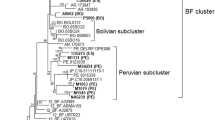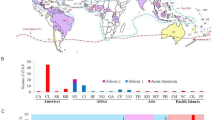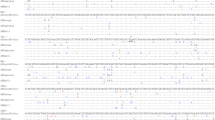Abstract
Similarly to other members of the Polyomaviridae family, BK virus (BKV) is thought to have co-evolved with its human host. BKV has four subtypes that are distinguishable by immunological reactivity, with two (subtypes I and IV) being most prevalent in human populations. Subtype I is the major subtype worldwide, whereas subtype IV is prevalent in East Asia and Europe but rare in Africa. The geographic distribution pattern of subtype IV BKV is in apparent disagreement with the hypothesis that BKV co-evolved with humans, since subtype IV rarely occurs in Africa. To elucidate the origin of subtype IV, 53 complete subtype IV sequences derived from East Asians and Europeans were subjected to a detailed phylogenetic analysis using the maximum-likelihood and neighbor-joining methods. We identified six subgroups (a1, a2, b1, b2, c1, and c2) that formed a tree represented by the formula: “(a1, a2), ((b1, b2), (c1, c2)).” Interestingly, we found a close correlation between subtype IV subgroups and population geography; thus, all subgroups except c2 were prevalent in particular East Asian populations, with c2 occurring in both Europe and Northeast Asia. From these findings, we conclude that subtype IV of BKV now prevalent in modern humans is derived from a virus that infected ancestral Asians. We introduce two hypotheses to explain how ancestral Asians became infected with subtype IV BKV.

Similar content being viewed by others
References
Akaike H (1974) A new look at the statistical model identification. IEEE Trans Aut Cont 19:716–723
Baksh FK, Finkelstein SD, Swalsky PA, Stoner GL, Ryschkewitsch CF, Randhawa P (2001) Molecular genotyping of BK and JC viruses in human polyomavirus-associated interstitial nephritis after renal transplantation. Am J Kidney Dis 38:354–365
Cantalupo P, Doering A, Sullivan CS, Pal A, Peden KW, Lewis AM, Pipas JM (2005) Complete nucleotide sequence of polyomavirus SA12. J Virol 79:13094–13104
Carr MJ, McCormack GP, Mutton KJ, Crowley B (2006) Unique BK virus non-coding control region (NCCR) variants in hematopoietic stem cell transplant recipients with and without hemorrhagic cystitis. J Med Virol 78:485–493
Chen Q, Zheng HY, Zhong S, Ikegaya H, He HX, Wei W, He YY, Kobayashi N, Honjo T, Takasaka T, Takahashi S, Kitamura T, Yogo Y (2006) Subtype IV of the BK polyomavirus is prevalent in East Asia. Arch Virol 151:2419–2429
Chesters PM, Heritage J, McCance DJ (1983) Persistence of DNA sequences of BK virus and JC virus in normal human tissues and in diseased tissues. J Infect Dis 147:676–684
Cole CN, Conzen SD (2001) Polyomaviridae: the viruses and their replication. In: Knipe DM, Howley PM (eds) Fields virology, 4th ed. Lippincott Williams & Wilkins, Philadelphia, pp 2141–2173
Di Taranto C, Pietropaolo V, Orsi GB, Jin L, Sinibaldi L, Degener AM (1997) Detection of BK polyomavirus genotypes in healthy and HIV-positive children. Eur J Epidemiol 13:653–657
Goldman N, Yang Z (1994) A codon-based model of nucleotide substitution for protein-coding DNA sequences. Mol Biol Evol 11:725–736
Heritage J, Chesters PM, McCance DJ (1981) The persistence of papovavirus BK DNA sequences in normal human renal tissue. J Med Virol 8:143–150
Hirsch HH, Brennan DC, Drachenberg CB, Ginevri F, Gordon J, Limaye AP, Mihatsch MJ, Nickeleit V, Ramos E, Randhawa P, Shapiro R, Steiger J, Suthanthiran M, Trofe J (2005) Polyomavirus-associated nephropathy in renal transplantation: interdisciplinary analyses and recommendations. Transplantation 79:1277–1286
Ikegaya H, Saukko PJ, Tertti R, Metsärinne KP, Carr MJ, Crowley B, Sakurada K, Zheng HY, Kitamura T, Yogo Y (2006) Identification of a genomic subgroup of BK polyomavirus spread in European populations. J Gen Virol 87:3201–3208
Jin L, Gibson PE, Booth JC, Clewley JP (1993) Genomic typing of BK virus in clinical specimens by direct sequencing of polymerase chain reaction products. J Med Virol 41:11–17
Jin L, Pietropaolo V, Booth JC, Ward KH, Brown DW (1995) Prevalence and distribution of BK virus subtypes in healthy people and immunocompromised patients detected by PCR-restriction enzyme analysis. Clin Diag Virol 3:285–295
Katoh K, Kuma K, Toh H, Miyata T (2005) MAFFT version 5: improvement in accuracy of multiple sequence alignment. Nucleic Acids Res 33: 511–518
Kishino H, Hasegawa M (1989) Evaluation of the maximum likelihood estimate of the evolutionary tree topologies from DNA sequence data, and the branching order in hominoidea. J Mol Evol 29:170–179
Kishino H, Miyata T, Hasegawa M (1990) Maximum likelihood inference of protein phylogeny, and the origin of chloroplasts. J Mol Evol 31:151–160
Knowles WA (2001) The epidemiology of BK virus and the occurrence of antigenic and genomic subtypes. In: Khalili K, Stoner GL (eds) Human polyomaviruses: molecular and clinical perspectives. John Wiley & Sons, New York, pp 527–559
Krumbholz A, Zell R, Egerer R, Sauerbrei A, Helming A, Gruhn B, Wutzler P (2006) Prevalence of BK virus subtype I in Germany. J Med Virol 78:1588–1598
Nishimoto Y, Takasaka T, Hasegawa M, Zheng HY, Chen Q, Sugimoto C, Kitamura T, Yogo Y (2006) Evolution of BK virus based on complete genome data. J Mol Evol 63:341–352
Padgett BL, Walker DL (1976) New human papovaviruses. Prog Med Virol 22:1–35
Perez-Losada M, Christensen RG, McClellan DA, Adams BJ, Viscidi RP, Demma JC, Crandall KA (2006) Comparing phylogenetic codivergence between polyomaviruses and their hosts. J Virol 80:5663–5669
Posada D, Crandall KA (1998) MODELTEST: testing the model of DNA substitution. Bioinformatics 14:817–818
Raymond M, Rousset F (1995) GENEPOP (version 1.2): a population genetic software for exact tests and ecumenicism. J Hered 86:248–249
Rodriguez F, Oliver JL, Marin A, Medina JR (1990) The general stochastic model of nucleotide substitution. J Theor Biol 142:485–501
Ruhlen M (1987) A guide to the world’s languages. Vol. 1. Classification. Stanford University Press, Stanford, CA
Seif I, Khoury G, Dhar R (1979) The genome of human papovavirus BKV. Cell 18:963–977
Shackelton LA, Rambaut A, Pybus OG, Holmes EC (2006) JC virus evolution and its association with human populations. J Virol 80:9928–9933
Simodaira H (2002) An approximately unbiased test of phylogenetic tree selection. Syst Biol 51:492–508
Shimodaira H, Hasegawa M (2001) CONSEL: for assessing the confidence of phylogenetic tree selection. Bioinformatics 17:1246–1247
Sugimoto C, Hasegawa M, Kato A, Zheng HY, Ebihara H, Taguchi F, Kitamura T, Yogo Y (2002) Evolution of human polyomavirus JC: implications for the population history of humans. J Mol Evol 54:285–297
Swofford DL (2002) PAUP*. Phylogenetic analysis using parsimony (*and other methods, version 4.0b10). Sinauer Associates, Sunderland, MA
Takasaka T, Goya N, Tokumoto T, Tanabe K, Toma H, Ogawa Y, Hokama S, Momose A, Funyu T, Fujioka T, Omori S, Akiyama H, Chen Q, Zheng HY, Ohta N, Kitamura T, Yogo Y (2004) Subtypes of BK virus prevalent in Japan and variation in their transcriptional control region. J Gen Virol 85:2821–2827
Tavis JE, Walker DL, Gardner SD, Frisque RJ (1989) Nucleotide sequence of the human polyomavirus AS virus, an antigenic variant of BK virus. J Virol 63:901–911
Wooding S (2001) Do human and JC virus genes show evidence of host-parasite codemography? Infect Genet Evol 1:3–12
Yang Z (1996) Among-site rate variation and its impact on phylogenetic analyses. TREE 11:367–372
Yang Z (1997) PAML: a program package for phylogenetic analysis by maximum likelihood. CABIOS 13:555–556
Yang Z, Nielsen R, Hasegawa M (1998) Models of amino acid substitution and applications to mitochondrial protein evolution. Mol Biol Evol 15:1600–1611
Yogo Y, Sugimoto C, Zheng HY, Ikegaya H, Takasaka T, Kitamura T (2004) JC virus genotyping offers a new paradigm in the study of human populations. Rev Med Virol 14:179–191
Zheng HY, Nishimoto Y, Chen Q, Hasegawa M, Zhong S, Ikegaya H, Ohno N, Sugimoto C, Takasaka T, Kitamura T, Yogo Y (2007) Relationships between BK virus lineages and human populations. Microbes Infect 9:204–213
Zhong S, Zheng HY, Chen Q, Ikegaya H, Suzuki M, Aoki N, Usuku S, Kobayashi N, Nukuzuma S, Yasuda Y, Kuniyoshi N, Yogo Y, Kitamura T (2007) Age-related urinary excretion of BK polyomavirus by nonimmunocompromised individuals. J Clin Microbiol 45:193–198
Acknowledgments
We thank Professor Masami Hasegawa for encouragement and helpful suggestions throughout this work. We are also grateful to all the urine donors for making the study possible. This study was supported in part by grants from the Ministry of Health, Labor and Welfare, Japan, from the Japan Society for the Promotion of Science, and from TRIC, Research Organization of Information and Systems.
Author information
Authors and Affiliations
Corresponding author
Additional information
[Reviewing Editor: Dr. Joshua Plotkin]
Yuriko Nishimoto and Huai-Ying Zheng are two authors contributed equally to this article.
Rights and permissions
About this article
Cite this article
Nishimoto, Y., Zheng, HY., Zhong, S. et al. An Asian Origin for Subtype IV BK Virus Based on Phylogenetic Analysis. J Mol Evol 65, 103–111 (2007). https://doi.org/10.1007/s00239-006-0269-6
Received:
Accepted:
Published:
Issue Date:
DOI: https://doi.org/10.1007/s00239-006-0269-6




